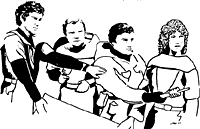

 |
 |
|
The Beginnings of
|
 drawing by Debby Stark
drawing by Debby Stark |
The British audience for "Blake's 7", at times about 10 million (almost one-fifth of the population), was approximately the same size as the one for "Doctor Who" during the same years. From out of this audience a nationwide phenomenon spread through the British Isles, inspiring a devoted fandom which created numerous organizations, conventions, and publications.
 by Debby Stark
by Debby Stark |
Even North America didn't remain immune to the phenomenon during its early years though it was more than a decade before "Blake's 7" aired on some PBS stations. Fantastic Films and The Starlog TV Episode Guides ran major articles on the show years before it was available in the U.S. Blake's 7 Monthly, published by Marvel in England, and the three novelizations of "Blake's 7" stories were available in the United States and Canada early on so there was a market for them.
Fanzines and clubs devoted to the show sprang up throughout the country. The first issue of the first American fanzine, B7 Complex, was published in the summer of 1981 by a group in Massachusetts. That same group later organized the Bored Without Blake (7) committee. A second fanzine, Fifth Season, came out of Maryland in the summer of 1982. Fans around Chicago started a club called Scorpio (after the team's ship in the fourth series) in the autumn of 1982, and they ran conventions for half a dozen years starting in 1983. A fifth issue of B7 Complex and a second issue of Fifth Season came out by mid-'83. Other zines which include "Blake's 7" material are currently being edited in New York, Oregon, Kansas, and West Virginia.
| The Cult Of Blakes 7 - Part II (see Part III)
|
The show has also recently inspired the publication of a hardcover book, Terry Nation's Blake's 7: The Programme Guide. The publication of such a book proves the point Tony Attwood makes in its prologue: " 'Blake's 7' grabbed the public imagination in a way that only a handful of programmes had ever done before."
As with life, the most consistent aspect of this show is change. Consequently, there may be as many varied responses to "Blake's 7" as there are people who have seen it. Each of the four series developed in its own way so viewers who like or dislike one season may have a totally different reaction to another.
The show has been described, at various times, as: a "Star Trek"-"Star Wars" hybrid or unlike either, Robin Hood in space or the IRA in space, extremely humorous or very serious, subtle or blatant, and idealistic or realistic. Some people think that "Blake's 7" involves seven characters of diverse, even alien backgrounds, who learn to care about each other in spite of themselves; others argue that it's about a peculiar group of people and machines who detest one another. (One of the strangest aspects about all these different viewpoints is that people on opposite sides of the arguments like the show precisely for the contrasting reasons.)
Perhaps even the people putting on the show never reached a consensus as to what they were doing or where they were going. The "Blake's 7" saga certainly takes some unusual turns; in the process it developes a unique life of its own.
|
|
Introduction |
The Beginning |
The Production Team |
Background
Characters | Morality & Humor | Sex & Death | Conclusion | Summary |